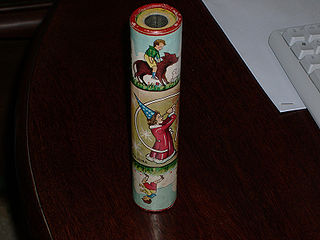
A kaleidoscope is an optical instrument with two or more reflecting surfaces tilted to each other in an angle, so that one or more objects on one end of the mirrors are seen as a regular symmetrical pattern when viewed from the other end, due to repeated reflection. The reflectors are usually enclosed in a tube, often containing on one end a cell with loose, colored pieces of glass or other transparent materials to be reflected into the viewed pattern. Rotation of the cell causes motion of the materials, resulting in an ever-changing view being presented.

Violet is the color at the end of the visible spectrum of light between blue and the invisible ultraviolet. Violet color has a dominant wavelength of approximately 380-450 nanometers. Light with a shorter wavelength than violet but longer than X-rays and gamma rays is called ultraviolet. In the color wheel historically used by painters, it is located between blue and purple. On the screens of computer monitors and television sets, a color which looks similar to violet is made, with the RGB color model, by mixing red and blue light, with the blue twice as bright as the red. This is not true violet, for it does not match the color of a single wavelength shorter than that of blue light.
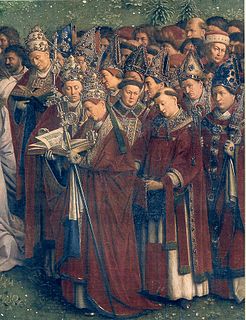
Purple is a color intermediate between blue and red. It is similar to violet, but unlike violet, which is a spectral color with its own wavelength on the visible spectrum of light, purple is a secondary color made by combining red and blue. The complementary color of purple is yellow.

Complementary colors are pairs of colors which, when combined or mixed, cancel each other out by producing a grayscale color like white or black. When placed next to each other, they create the strongest contrast for those two colors. Complementary colors may also be called "opposite colors."
In the visual arts, color theory or colour theory is a body of practical guidance to color mixing and the visual effects of a specific color combination. There are also definitions of colors based on the color wheel: primary color, secondary color, and tertiary color. Although color theory principles first appeared in the writings of Leone Battista Alberti and the notebooks of Leonardo da Vinci, a tradition of "colory theory" began in the 18th century, initially within a partisan controversy over Isaac Newton's theory of color and the nature of primary colors. From there it developed as an independent artistic tradition with only superficial reference to colorimetry and vision science.
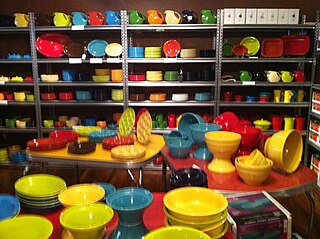
Fiesta, often called Fiestaware, is a line of ceramic glazed dinnerware manufactured and marketed by the Homer Laughlin China Company of Newell, West Virginia since its introduction in 1936, with a hiatus from 1973 to 1985. Fiesta is noted for its Art Deco styling featuring concentric circles—and its range of solid colors.

Fire-King is an Anchor Hocking brand of glassware similar to Pyrex. It was formerly made of low expansion borosilicate glass and ideal for oven use. Currently it is made of tempered soda-lime-silicate glass.

Uranium glass is glass which has had uranium, usually in oxide diuranate form, added to a glass mix before melting for coloration. The proportion usually varies from trace levels to about 2% uranium by weight, although some 20th-century pieces were made with up to 25% uranium.

Carnival glass is moulded or pressed glass, always with a pattern and always with a shiny, metallic, 'iridescent' surface shimmer.

Depression glass is clear or colored translucent machine made glassware that was distributed free, or at low cost, in the United States and Canada around the time of the Great Depression.
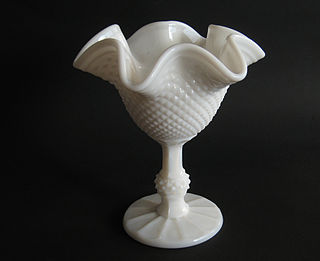
Milk glass is an opaque or translucent, milk white or colored glass that can be blown or pressed into a wide variety of shapes. First made in Venice in the 16th century, colors include blue, pink, yellow, brown, black, and the white that led to its popular name.

Sea glass and beach glass are similar but come from two different types of water. "Sea glass" is physically and chemically weathered glass found on beaches along bodies of salt water. These weathering processes produce natural frosted glass. "Genuine sea glass" can be collected as a hobby and is used for decoration, most commonly in jewelry. "Beach glass" comes from fresh water and in most cases has a different pH balance and a less frosted appearance than sea glass. Sea glass takes 20 to 40 years, and sometimes as much as 100 years, to acquire its characteristic texture and shape. Sometimes also colloquially referred to as "Drift glass" from the longshore drift process that forms the smooth edges. In practice, the two terms are used interchangeably.
Goofus glass is pressed glass which was decorated with cold, unfired paint in the early 20th century in America by several prominent glass factories. Because it was mass-produced and relatively cheap, it was given as a premium for buying things and awarded as prizes at fairs. It was the first carnival glass, preceding the iridized product known as carnival glass today.
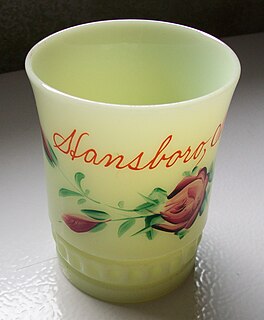
The A.H. Heisey Company was formed in Newark, Ohio, in 1895 by A.H. Heisey. The factory provided fine quality glass tableware and decorative glass figurines. Both pressed and blown glassware were made in a wide variety of patterns and colors. The company also made glass automobile headlights and Holophane Glassware lighting fixtures. The company was operated by Heisey and his sons until 1957, when the factory closed.

The Fenton Art Glass Company was founded in 1905 by brothers Frank L. Fenton and John W. Fenton.
The Fostoria Glass Company manufactured pressed, blown and hand-molded glassware and tableware for almost 100 years. It began operations in Fostoria, Ohio, on December 15, 1887, on land donated by the townspeople. The new company was formed by men from West Virginia, who were experienced in the glassmaking business. They started their company in northwest Ohio to take advantage of newly discovered natural gas that was an ideal fuel for glassmaking. Numerous other businesses were started in the area, and the supply of natural gas began to diminish. Fuel shortages caused the company to move to Moundsville, West Virginia in 1891.

Cameo glass is a luxury form of glass art produced by cameo etching and carving through fused layers of differently colored glass to produce designs, usually with white opaque glass figures and motifs on a dark-colored background. The technique is first seen in ancient Roman art of about 30 BC, where it was an alternative to the more luxurious engraved gem vessels in cameo style that used naturally layered semi-precious gemstones such as onyx and agate. Glass allowed consistent and predictable colored layers, even for round objects.
The Macbeth-Evans Glass Company was an American glass company that created very fine glassware with beautiful designs but is famous for making depression glass.
Apple Inc. products have had a number of various design motifs since its inception. Recent motifs were mainly developed under the collaboration of Steve Jobs and Sir Jonathan Ive beginning in 1997, radically altering the previous Apple computer designs.















